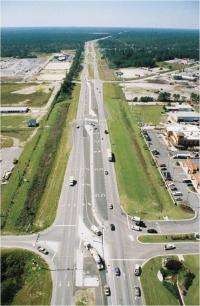No left turn: 'Superstreet' traffic design improves travel time, safety

The so-called "superstreet" traffic design results in significantly faster travel times, and leads to a drastic reduction in automobile collisions and injuries, according to North Carolina State University researchers who have conducted the largest-ever study of superstreets and their impacts.
Superstreets are surface roads, not freeways. It is defined as a thoroughfare where the left-hand turns from side streets are re-routed, as is traffic from side streets that needs to cross the thoroughfare. In both instances, drivers are first required to make a right turn and then make a U-turn around a broad median. While this may seem time-consuming, the study shows that it actually results in a significant time savings since drivers are not stuck waiting to make left-hand turns or for traffic from cross-streets to go across the thoroughfare.
"The study shows a 20 percent overall reduction in travel time compared to similar intersections that use conventional traffic designs," says Dr. Joe Hummer, professor of civil, construction and environmental engineering at NC State and one of the researchers who conducted the study. "We also found that superstreet intersections experience an average of 46 percent fewer reported automobile collisions – and 63 percent fewer collisions that result in personal injury."

The researchers assessed travel time at superstreet intersections as the amount of time it takes a vehicle to pass through an intersection from the moment it reaches the intersection – whether traveling left, right or straight ahead. The travel-time data were collected from three superstreets located in eastern and central North Carolina, all of which have traffic signals. The superstreet collision data were collected from 13 superstreets located across North Carolina, none of which have traffic signals.
The superstreet concept has been around for over 20 years, but little research had been done to assess its effectiveness under real-world conditions. The NC State study is the largest analysis ever performed of the impact of superstreets in real traffic conditions.
More information: A paper on the travel time research is being presented Jan. 24 at the Transportation Research Board Annual Meeting in Washington, D.C.
Provided by North Carolina State University


















